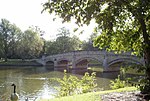National Space Centre
2001 establishments in EnglandAerospace museums in EnglandAstronomy museumsBuildings and structures celebrating the third millenniumBuildings and structures completed in 2001 ... and 13 more
Buildings and structures in LeicesterMuseums in LeicesterNicholas Grimshaw buildingsPlanetaria in the United KingdomScience and technology in the United KingdomScience museums in EnglandSpace-related tourist attractionsSpace programme of the United KingdomTechnology museums in the United KingdomTourist attractions in LeicestershireUniversity museums in the United KingdomUniversity of LeicesterUse British English from January 2014

The National Space Centre is a museum and educational resource covering the fields of space science and astronomy, along with a space research programme in partnership with the University of Leicester. It is located on the north side of the city in Belgrave, Leicester, England, next to the River Soar. Many of the exhibits, including upright rockets, are housed in a tower with minimal steel supports and a semi-transparent cladding of ETFE 'pillows' which has become one of Leicester's most recognisable landmarks. The National Space Centre is a registered charity with a board of trustees.
Excerpt from the Wikipedia article National Space Centre (License: CC BY-SA 3.0, Authors, Images).National Space Centre
Nincoper Straße, Hamburg Neuenfelde (Harburg)
Geographical coordinates (GPS) Address Nearby Places Show on map
Geographical coordinates (GPS)
| Latitude | Longitude |
|---|---|
| N 52.653611111111 ° | E -1.1322222222222 ° |
Address
Nincoper Straße 141
21129 Hamburg, Neuenfelde (Harburg)
Deutschland
Open on Google Maps









